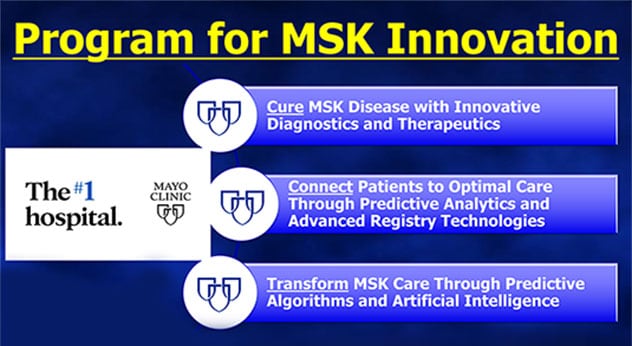Aug. 06, 2021
Matthew P. Abdel, M.D., an orthopedic surgeon at Mayo Clinic in Rochester, Minnesota, answers questions about artificial intelligence (AI) and other research goals in Orthopedic Surgery. Dr. Abdel was recently named chair of Mayo Clinic's Orthopedic Surgery Research.
Why is AI a primary focus of Mayo Clinic's orthopedic surgery research?
All of our research priorities are based on the needs of our patients. Our basic science researchers as well as our clinician-investigators are all engaged in research that is directly translatable to clinical practice.
Musculoskeletal innovation goals

Musculoskeletal innovation goals
Schematic describes Mayo Clinic's goals for musculoskeletal (MSK) innovation.
AI has a strong potential to improve patient care through the development of predictive analytics to guide surgical decision-making. One example is AI analytics to predict whether or not a prosthetic implant is fixed or loose. But the potential applications of AI touch all nine of our Orthopedic Surgery clinical divisions. Our goal is to transform musculoskeletal care through predictive algorithms and AI.
What infrastructure does Mayo Clinic have for building predictive analytics?
In addition to orthopedic surgical subject matter experts, Mayo Clinic has robust data sets for most orthopedic subspecialties. For example, in hip and knee arthroplasty, we have a patient registry that has captured clinical, radiographic, demographic and operative details going back to March 1969. That type of longitudinal data is key to developing the algorithms that drive predictive analytics.
Applying predictive analytics to individual patients requires state-of-the-art imaging. Mayo Clinic also has a long tradition of imaging expertise that will facilitate the development of AI-based applications.
What additional priorities is the research division pursuing?
In addition to AI, our 2030 strategic vision focuses on cartilage regeneration, infection prevention and treatment, fibrosis, arthritis, and orthopedic oncology.
How might research focused on cartilage regeneration benefit patients?
Pharmacological and gene therapies that slow the degeneration of cartilage can help individuals avoid joint replacement surgery. Patients are eager for nonsurgical options. Like AI, cartilage regeneration can impact many of the services we provide, including our upper and lower extremity practices, spine practice, pediatric orthopedics, and sports medicine.
What does Mayo Clinic hope to achieve regarding orthopedic infection research?
One particular issue we hope to clarify is whether bacteriophages play any role in treating periprosthetic joint infections. As described in Clinical Infectious Diseases, Mayo Clinic successfully used phage therapy to treat a 62-year-old man with a history of knee arthroplasty and multiple episodes of prosthetic knee infection — avoiding the need for amputation.
Infections can plague any bone, muscle, ligament, tendon or joint. The prevention and treatment of these orthopedic infections is evolving rapidly, and Mayo Clinic is committed to innovation.
What are Mayo Clinic's goals in fibrosis and arthritis research?
We are working to develop pharmacological modalities that both prevent and treat fibrosis in the musculoskeletal system. Similarly, learning more about the pathogenesis of arthritis, and how we might slow or prevent its development, is key.
All of our research aims ultimately focus around curing musculoskeletal diseases with innovative diagnostics and therapeutics. Moreover, we want to connect patients to optimal care through predictive analytics and advanced registry technologies.
For more information
Cano EJ, et al. Phage therapy for limb-threatening prosthetic knee Klebsiella pneumoniae infection: Case report and in vitro characterization of anti-biofilm activity. Clinical Infectious Diseases. 2021;73:e144.